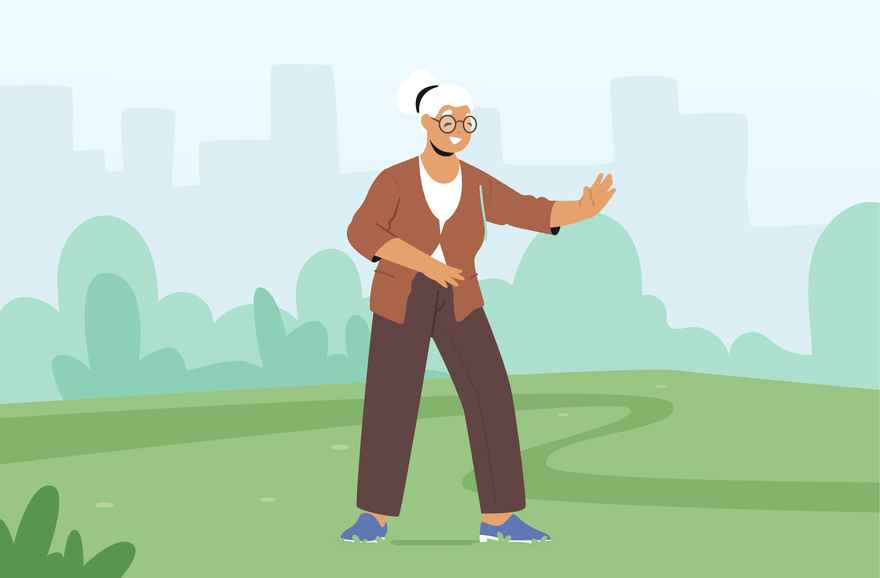Not exercise!

People who aren't familiar with yoga or qigong often think these are types of 'exercise' — activities for people who intend to improve or train their body.
For example, people might exercise to get good at a physical skill, or they exercise to develop a strong body, or they want to be more physically attractive. So they exercise.
The exercise attitude has come down to us from the athleticism of ancient Greece (think the Olympics!). The exercise attitude dominates the modern world with its emphasis on sports and physical trainers.
Yoga and qigong could be labelled as exercise -- yes, they are physical practices with a potential to affect the body's strength, stamina, agility, etc. But they cultivate a quality of inner awareness and intention that's absent, or different, from what is usually emphasized in exercise.
Practitioners of yoga and qigong often consider these to be practices of 'meditative movement' or 'body awareness' -- distinct from 'exercise'.
And science is now confirming their transformative power. Practices of slow meditative movement, or even just simple awareness of body postures, have been shown to significantly affect the body and mind.
Dana R. Carney is an American psychologist with a particular interest in business matters. She’s best known for her study of the psychological effects of posture, especially her 2010 paper : “Power posing: brief nonverbal displays affect neuroendocrine levels and risk tolerance”. [1]
That paper showed that just changing your posture can affect your psychological state, and even hormone levels.
In this research, participants were asked to pose in one of two very different body postures.
One posture was considered to be a 'high-power pose'. It displayed ‘dominance’ (described as an ‘open expansive’ posture).
The second posture was considered to be a 'low-power pose'. It displayed ‘defeat’ (described as a ‘closed, contractive’ posture).
After posing in one of these 2 postures, participants then underwent psychological tests and tests of hormone levels.
Researchers summarized their results:
“High-power posers experienced elevations in testosterone, decreases in cortisol, and increased feelings of power and tolerance for risk; low-power posers exhibited the opposite pattern.” [NOTE: Cortisol is usually considered to be a stress hormone]
In other words, participants' psychological state was affected by assuming a particular body posture. Dominant poses helped people feel dominant! A pose that displayed defeat helped people feel defeated!
Unfortunately, this research has been disputed (even by the author!), but other researchers give evidence to support it. And, business coaches use this research when they encourage their clients to boost confidence by adopting a ‘dominant’ posture. They say it works!
This research doesn’t surprise students of hatha yoga. Yoga practitioners often experience the psychological effect of posture. For example, certain dynamic yoga poses have been named ‘warrior poses'. A pose of passive surrender is named ‘child’s pose’.
Qigong is an ancient Chinese tradition of slow meditative movement and mindful breathing. You may be familiar with tai chi, a particular form of qigong.
Researchers have been investigating the healing properties of qigong practice. Results are encouraging, even inspiring.
For example, a 2020 research paper is ‘‘Making Peace with Our Bodies’’: A Qualitative Analysis of Breast Cancer Survivors’ Experiences with Qigong Mind–Body Exercise”. [2]
In this research paper, cancer survivors describe “feeling whole again, reconnecting mind and body.” “being aware of all that is working well and feeling good”.
Another paper, published in 2022, is: “Qigong Training Positively Impacts Both Posture and Mood in Breast Cancer Survivors With Persistent Post-surgical Pain: Support for an Embodied Cognition Paradigm”. [3]
In this study, cancer survivors again reported benefit from qigong. During their weeks of practice, they experiemced significant reduction of pain and cancer-related fatigue and inflammation. Researchers noted that, as a woman’s posture improved, so too did her pain and inflammation.
SUGGESTION FOR BRIEF PRACTICE
Here's an invitation to explore your present moment experience of posture. These questions help to guide your attention.
Hint: Don't hurry. Just witness your experience. You might like to close your eyes, even briefly,
How are you?
How are you feeling right now? just being here...
What's your experience of sitting in this way? your feeling of being in this posture... Breathing...
Do your mood and your posture feel somehow related?... Notice you can reposition if you'd like...
How would you like to sit right now? What seated posture feels best?...
Experiment. Why not just sit here and breathe?... No rush!
To your natural happiness!
Lucinda
CITATIONS
[1] Power posing: brief nonverbal displays affect neuroendocrine levels and risk tolerance; Dana R. Carney et al; Psychol Sci 2010 Oct;
[2] Making Peace with Our Bodies’’: A Qualitative Analysis of Breast Cancer Survivors’ Experiences with Qigong Mind–Body Exercise; Kamila Osypiuk et al; Jnl Altern Complem Med. 2020 Sep
[3] Qigong Training Positively Impacts Both Posture and Mood in Breast Cancer Survivors With Persistent Post-surgical Pain: Support for an Embodied Cognition Paradigm; Ana Paula Quixadá et al; Front Psychol. 2022 Feb 21;

